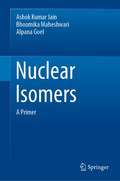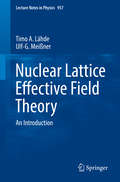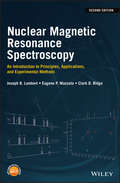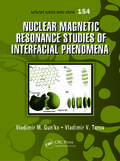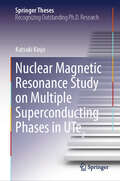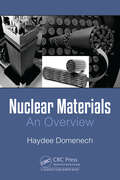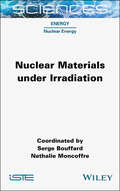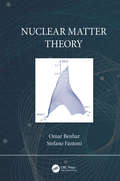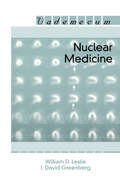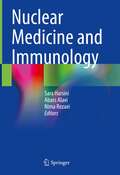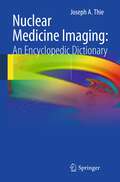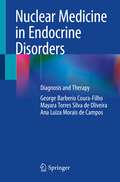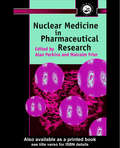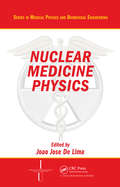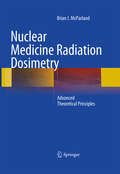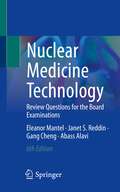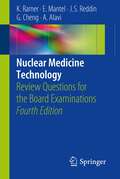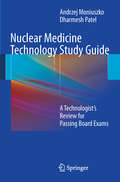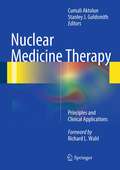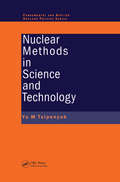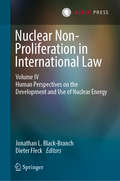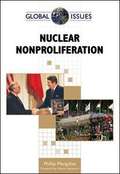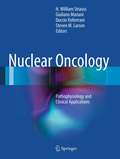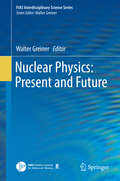- Table View
- List View
Nuclear Iran
by Jeremy BernsteinThis succinct book is timely reading for anyone who wishes to understand the maze of science and secrecy at the heart of Iran's nuclear ambitions. Writing for the general reader, Jeremy Bernstein draws on his knowledge as a physicist to elucidate the scientific principles and technical hurdles involved in creating nuclear reactors and bombs.
Nuclear Isomers: A Primer
by Ashok Kumar Jain Bhoomika Maheshwari Alpana GoelNuclear isomers are the long-lived excited states of nuclei. Therefore, they constitute the meta-stable landscape of nuclei. The first isomer was probably identified as early as 1921. Since then, the number of isomers has been growing steadily picking up pace in recent times.Interest in nuclear isomers has grown in recent years for many reasons. The experimental capabilities to observe isomers have been expanding to cover a wider time scale. This has opened up new windows to observe and decipher the underlying nuclear structure and interactions. Further, the isomers are beginning to be seen as potential energy storage devices and nuclear clocks with a host of applications. Possible discovery of a gamma ray laser has also ignited many researches in this area.Isomers now cover the full nuclear landscape with structural peculiarities specific to each region of the nuclear chart. Exploring the nuclear isomers, therefore, provides a novel insight into the nuclear structure properties of that region. There could be many different reasons for the long lives of excited nuclear states, which lead to the classification of isomers.Isomers are broadly classified in to four classes: Spin isomers, shape isomers, fission isomers and K-isomers. Seniority isomers have also been identified which are often clubbed with the spin isomers. We discuss this classification and the underlying causes in detail. Many examples are considered to highlight the large variety of isomers. The range of half-lives covered by the isomers varies from billions of years to nano-seconds and even small. To understand this vast variation is a fascinating endeavor in itself. The angular momentum couplings, nuclear shapes, pairing etc. conspire together to give this vast range of half-lives. We go through these aspects in detail, highlighting the various selection rules at work.It is interesting that the nuclear shapes play an important role in many types of isomers. The spin isomers, which occur in spherical or, near-spherical nuclei, are generally confined to the magic numbers. Seniority isomers are largely found in semi-magic nuclei and should be explored in conjunction with the spin isomers. New developments in seniority and generalized seniority isomers are discussed in detail. As the nuclei deform; the nature of isomers changes. We take a close look into the decay properties of isomers in deformed nuclei, particularly the K isomers, the shape isomers and the fission isomers. While doing so, the theoretical and experimental developments of isomers are also addressed. A number of open questions are posed for possible new experiments and better understanding of the isomers.
Nuclear Lattice Effective Field Theory: An Introduction (Lecture Notes in Physics #957)
by Timo A. Lähde Ulf-G. MeißnerThis primer begins with a brief introduction to the main ideas underlying Effective Field Theory (EFT) and describes how nuclear forces are obtained from first principles by introducing a Euclidean space-time lattice for chiral EFT. It subsequently develops the related technical aspects by addressing the two-nucleon problem on the lattice and clarifying how it fixes the numerical values of the low-energy constants of chiral EFT. In turn, the spherical wall method is introduced and used to show how improved lattice actions render higher-order corrections perturbative. The book also presents Monte Carlo algorithms used in actual calculations. In the last part of the book, the Euclidean time projection method is introduced and used to compute the ground-state properties of nuclei up to the mid-mass region. In this context, the construction of appropriate trial wave functions for the Euclidean time projection is discussed, as well as methods for determining the energies of the low-lying excitations and their spatial structure. In addition, the so-called adiabatic Hamiltonian, which allows nuclear reactions to be precisely calculated, is introduced using the example of alpha-alpha scattering. In closing, the book demonstrates how Nuclear Lattice EFT can be extended to studies of unphysical values of the fundamental parameters, using the triple-alpha process as a concrete example with implications for the anthropic view of the Universe. Nuclear Lattice Effective Field Theory offers a concise, self-contained, and introductory text suitable for self-study use by graduate students and newcomers to the field of modern computational techniques for atomic nuclei and nuclear reactions.
Nuclear Magnetic Resonance Spectroscopy: An Introduction to Principles, Applications, and Experimental Methods
by Joseph B. Lambert Eugene Mazzola Clark D. RidgeCombines clear and concise discussions of key NMR concepts with succinct and illustrative examples Designed to cover a full course in Nuclear Magnetic Resonance (NMR) Spectroscopy, this text offers complete coverage of classic (one-dimensional) NMR as well as up-to-date coverage of two-dimensional NMR and other modern methods. It contains practical advice, theory, illustrated applications, and classroom-tested problems; looks at such important ideas as relaxation, NOEs, phase cycling, and processing parameters; and provides brief, yet fully comprehensible, examples. It also uniquely lists all of the general parameters for many experiments including mixing times, number of scans, relaxation times, and more. Nuclear Magnetic Resonance Spectroscopy: An Introduction to Principles, Applications, and Experimental Methods, 2nd Edition begins by introducing readers to NMR spectroscopy - an analytical technique used in modern chemistry, biochemistry, and biology that allows identification and characterization of organic, and some inorganic, compounds. It offers chapters covering: Experimental Methods; The Chemical Shift; The Coupling Constant; Further Topics in One-Dimensional NMR Spectroscopy; Two-Dimensional NMR Spectroscopy; Advanced Experimental Methods; and Structural Elucidation. Features classical analysis of chemical shifts and coupling constants for both protons and other nuclei, as well as modern multi‐pulse and multi-dimensional methods Contains experimental procedures and practical advice relative to the execution of NMR experiments Includes a chapter-long, worked-out problem that illustrates the application of nearly all current methods Offers appendices containing the theoretical basis of NMR, including the most modern approach that uses product operators and coherence-level diagrams By offering a balance between volumes aimed at NMR specialists and the structure-determination-only books that focus on synthetic organic chemists, Nuclear Magnetic Resonance Spectroscopy: An Introduction to Principles, Applications, and Experimental Methods, 2nd Edition is an excellent text for students and post-graduate students working in analytical and bio-sciences, as well as scientists who use NMR spectroscopy as a primary tool in their work.
Nuclear Magnetic Resonance Studies of Interfacial Phenomena (Surfactant Science)
by Vladimir M. Gun'ko Vladimir V. TurovProperties and applications of high surface area materials depend on interfacial phenomena, including diffusion, sorption, dissolution, solvation, surface reactions, catalysis, and phase transitions. Among the physicochemical methods that give useful information regarding these complex phenomena, nuclear magnetic resonance (NMR) spectroscopy is the
Nuclear Magnetic Resonance Study on Multiple Superconducting Phases in UTe2 (Springer Theses)
by Katsuki KinjoThis book provides an insight into spin-triplet superconductivity, which rapidly becomes better understood in recent years, from the perspective of a microscopic measurement technique called nuclear magnetic resonance (NMR). The compound UTe2, the target material of this book, was confirmed to show superconductivity in 2018, and its peculiarity is very similar to that of other uranium-based ferromagnetic superconductors, ensuring spin triplet superconductivity. This book begins with the fundamentals of superconductivity and subsequently overviews research in spin-triplet superconductivity. The similarity between the high-field superconducting phase in UTe2 and the superconducting phase under pressure is particularly interesting among the various superconducting phenomena observed so far. This book provides a concise introduction to superconductivity, so that the book is also intended for wide readership including the beginners interested in the phenomenon of superconductivity and undergraduate and graduate students. It also cover the NMR measurement from the basic derivation, which is accessible for beginners. The target material UTe2 is skillfully described, including a selection of related works to this book.
Nuclear Materials: An Overview
by Haydee DomenechThis book reviews the critical scope of nuclear materials, which play an essential role in decreasing greenhouse gas emissions. It traces historical landmarks from the years preceding World War II to the atomic bomb era. Key topics covered include the concept of nuclear materials and their connection to the Non-Proliferation Treaty (NPT), the steps of the nuclear fuel cycle, and advanced reactor technologies. Additionally, the book addresses safety and security considerations, including radioactive waste and spent fuel management. Through this comprehensive exploration, readers can gain insights into the intricate world of nuclear materials, their impact on global security, and the path toward sustainable energy solutions.
Nuclear Materials under Irradiation
by Serge Bouffard Nathalie MoncoffreAt every stage of the fuel cycle, the materials used are at the heart of nuclear energy safety issues. These materials, which range from steel to polymers, including ceramics, glass, concrete and graphite, are submitted to extreme stresses combining mechanical, thermal and irradiation constraints. The objective of this book is to provide a basis for the research of nuclear materials subjected to irradiation, with the desire to contextualize them in the industrial environment. Therefore, most of the chapters are co-authored and contain a mix of basic and applied research. The reader will find chapters on nuclear reactor materials (structural materials, neutron absorbers, moderators and nuclear fuel) and on materials in waste management (glass, concrete and organic materials). These material chapters are complemented by more general information on defects and their creation, radiolysis and irradiation and characterization tools.
Nuclear Matter Theory
by Omar Benhar Stefano FantoniAuthored by two of the most respected experts in the field of nuclear matter, this book provides an up-to-date account of developments in nuclear matter theory and a critical comparison of the existing theoretical approaches in the field. It provides information needed for researchers working with applications in a variety of research fields, ranging from nuclear physics to astrophysics and gravitational physics, and the computational techniques discussed in the book are relevant for the broader condensed matter and quantum fluids community. The first book to provide an up-to-date and comprehensive overview of nuclear matter theory Authored by two world-leading academics in this field Includes a description of the most advanced computational techniques and a discussion of state-of-the art applications, such as the study of gravitational-wave emission from neutron stars
Nuclear Medicine
by William D. Leslie I. David GreenbergThe material covers traditional aspects of Nuclear Medicine as well as the newest advances in the field. In this handbook, the role of Nuclear Medicine techniques in diagnosis and treatment is presented in conjunction with the essential elements of radiopharmacology, instrumentation and radiation protection.
Nuclear Medicine and Immunology
by Sara Harsini Abass Alavi Nima RezaeiThis book explores the close connection between immunology and nuclear medicine, which has led to radioimmunoimaging and radioimmunotherapy (RIT). Molecular imaging with positron emission tomography (PET) and single-photon emission computed tomography (SPECT) is increasingly being used to diagnose, characterize, and monitor disease activity in the context of inflammatory disorders of known and unknown etiology, such as sarcoidosis, atherosclerosis, vasculitis, inflammatory bowel disease, rheumatoid arthritis, and degenerative joint disease. The first chapters discuss the various radiopharmaceutical agents and radiolabeled preparations that have been employed in inflammation imaging. Of these, FDG-PET imaging has been shown to have the great value in the detection of inflammation and has become the centerpiece of several initiatives over the last several years. This very powerful technique will play an increasingly important role in the management of patients with inflammatory conditions in the future. The book also explores the growing role of nuclear medicine and molecular imaging in the diagnosis and treatment of cancer. The rapid pace of change has been fueled by advances in our understanding of tumor biology, on the one hand, and the development of specifically targeted medical therapies, diagnostic agents, and radiotherapies, on the other. Written by leading international experts in the field, this book is an invaluable tool for nuclear medicine physicians, radiologists, oncologists, and immunologists.
Nuclear Medicine Imaging: An Encyclopedic Dictionary
by Joseph A. ThieThe rapidly growing area of nuclear medicine imaging receives only limited attention in broad-based medical dictionaries. This encyclopedic dictionary is intended to fill the gap. More than 400 entries of between one and three paragraphs are included, defining and carefully explaining terms in an appropriate degree of detail. The dictionary encompasses concepts used in planar, SPECT, and PET imaging protocols and covers both scanner operations and popular data analysis approaches. In spite of the mathematical complexities in the acquisition and analysis of images, the explanations given are easy to understand and many helpful concrete examples are provided. The book will be ideal for those who wish to obtain a rapid grasp of a concept beyond a definition of a few words but do not have the time to search the reference literature. The almost tutorial-like style accommodates the needs of students, nuclear medicine technologists, and varieties of other medical professionals.
Nuclear Medicine in Endocrine Disorders: Diagnosis and Therapy
by George Barberio Coura-Filho Mayara Torres Silva de Oliveira Ana Luiza Morais de CamposThis book presents up-to-date information on the general principles of diagnostic and therapeutic nuclear medicine in the context of endocrinology. The content is divided into six parts. Section I examines general aspects of radiopharmaceuticals, scintigraphy, single-photon emission computed tomography (SPECT), positron emission tomography (PET), radionuclide therapies and radioguided surgery. Section II discusses diagnostic applications in benign thyroid diseases and evaluation of thyroid nodules. Section III gives an overview of the management of parathyroid diseases. Section IV presents diagnostic techniques in well-differentiated thyroid cancer. Section V addresses procedures and therapy in adrenal benign and malignant disorders (phaechromocytomas and paragangliomas). Lastly, the diagnosis and treatment of neuroendocrine tumors are featured in Section VI. Nuclear Medicine in Endocrine Disorders: Diagnosis and Therapy is intended for non-specialists in nuclear medicine working in the field of endocrinology, and is also a valuable resource for researchers and students.
Nuclear Medicine in Pharmaceutical Research
by A. C. Perkins M. FrierThis text defines the role and scope of nuclear medicine imaging techniques (gamma scintigraphy) in pharmaceutical research, giving information from clinical trial data.
Nuclear Medicine Physics (Series in Medical Physics and Biomedical Engineering)
by J. J. Pedroso de LimaEdited by a renowned international expert in the field, Nuclear Medicine Physics offers an up-to-date, state-of-the-art account of the physics behind the theoretical foundation and applications of nuclear medicine. It covers important physical aspects of the methods and instruments involved in modern nuclear medicine, along with related biological
Nuclear Medicine Radiation Dosimetry
by Brian J McparlandComplexities of the requirements for accurate radiation dosimetry evaluation in both diagnostic and therapeutic nuclear medicine (including PET) have grown over the past decade. This is due primarily to four factors: Growing consideration of accurate patient-specific treatment planning for radionuclide therapy as a means of improving the therapeutic benefit, development of more realistic anthropomorphic phantoms and their use in estimating radiation transport and dosimetry in patients, Design and use of advanced Monte Carlo algorithms in calculating the above-mentioned radiation transport and dosimetry which require the user to have a thorough understanding of the theoretical principles used in such algorithms, their appropriateness and their limitations, increasing regulatory scrutiny of the radiation dose burden borne by nuclear medicine patients in the clinic and in the development of new radiopharmaceuticals, thus requiring more accurate and robust dosimetry evaluations. An element common to all four factors is the need for precise radiation dosimetry in nuclear medicine, which is fundamental to the therapeutic success of a patient undergoing radionuclide therapy and to the safety of the patients undergoing diagnostic nuclear medicine and PET procedures. As the complexity of internal radiation dosimetry applied to diagnostic and therapeutic nuclear medicine increases, this book will provide the theoretical foundations for: enabling the practising nuclear medicine physicist to understand the dosimetry calculations being used and their limitations, allowing the research nuclear medicine physicist to critically examine the internal radiation dosimetry algorithms available and under development; and providing the developers of Monte Carlo codes for the transport of radiation resulting from internal radioactive sources with the only comprehensive and definitive.
Nuclear Medicine Technology: Review Questions for the Board Examinations
by Eleanor Mantel Janet S. Reddin Gang Cheng Abass AlaviThis textbook now published in its 6th edition prepares students and technologists for registry examinations in nuclear medicine technology by providing practice questions and answers with detailed explanations, as well as a mock registry exam. The questions are designed to test the basic knowledge required of nuclear medicine technologists, as well as the practical application of that knowledge. The topics covered closely follow the content specifications and the components of preparedness as published by the certification boards. This new edition now includes new tracers for diagnostic imaging and therapeutic applications as well as other newly approved procedures. Coverage of positron emission tomography and hybrid multimodality imaging in the field of nuclear medicine and molecular imaging has also been expanded.
Nuclear Medicine Technology: Review Questions for the Board Examinations
by Janet S. Reddin Eleanor Mantel Gang Cheng Abass Alavi Karen RamerThis book prepares students and technologists for registry examinations in nuclear medicine technology by providing practice questions and answers with detailed explanations, as well as a mock registry exam. The questions are designed to test the basic knowledge required of nuclear medicine technologists, as well as the practical application of that knowledge. The topics covered closely follow the content specifications and the components of preparedness as published by the certification boards. This 4th edition includes expanded coverage of positron emission tomography and other new procedures and practices in the field of nuclear medicine and molecular imaging.
Nuclear Medicine Technology Study Guide
by Andrzej Moniuszko Dharmesh PatelNuclear Medicine Technology Study Guide presents a comprehensive review of nuclear medicine principles and concepts necessary for technologists to pass board examinations. The practice questions and content follow the guidelines of the Nuclear Medicine Technology Certification Board (NMTCB) and American Registry of Radiological Technologists (ARRT), allowing test takers to maximize their success in passing the examinations. The book is organized by sections of increasing difficulty, with over 600 multiple-choice questions covering all areas of nuclear medicine, including radiation safety; radionuclides and radiopharmaceuticals; instrumentation and quality control; patient care; and diagnostic and therapeutic procedures. Detailed answers and explanations to the practice questions follow. Supplementary chapters will include nuclear medicine formulas, numbers, and a glossary of terms for easy access by readers. Additionally, test-taking strategies are covered.
Nuclear Medicine Therapy
by Cumali Aktolun Stanley J. GoldsmithNuclear Medicine Therapy presents the state of the art in targeted radionuclide therapy, both in clinical practice and contemporary clinical investigation and trials. With contributions from an internationally-distinguished group of physicians and scientists, the book is devoted entirely to the use of nuclear medicine techniques and technology for therapy of malignant and benign diseases. Individual chapters cover the scientific principles and clinical applications of radionuclide therapy and the state of clinical trials of agents currently under investigation in the therapy of tumors involving virtually every organ system. Due to overlapping interest in techniques, indications, and clinical use, the development of radionuclide therapy attracts considerable input from other medical specialists whose collaboration is essential, including radiation and medical oncologists, hematologists, diagnostic radiologists, hepatologists, endocrinologists, and rheumatologists. And because radionuclide therapy is a rapidly evolving field of nuclear medicine, it is the aim of this volume to appeal to all specialists involved in targeted radionuclide therapy and to contribute to the standardization of the practice globally.
Nuclear Methods in Science and Technology (Series In Fundamental And Applied Nuclear Physics Ser.)
by Yuri M. TsipenyukThe application of nuclear physics methods is now widespread throughout physics, chemistry, metallurgy, biology, clinical medicine, geology, and archaeology. Accelerators, reactors, and various instruments that have developed together with nuclear physics have often been found to offer the basis for increasingly productive and more sensitive analytical techniques.Nuclear Methods in Science and Technology provides scientists and engineers with a clear understanding of the basic principles of nuclear methods and their potential for applications in a wide range of disciplines. The first part of the book covers the major points of basic theory and experimental methods of nuclear physics, emphasizing concepts and simple models that give a feel for the behavior of real systems. Using many examples, the second part illustrates the extraordinary possibilities offered by nuclear methods. It covers the Mossbauer effect, slow neutron physics, activation analysis, radiography, nuclear geochronology, channeling effects, nuclear microprobe, and numerous other topics in modern applied nuclear physics. The book explores applications such as tomography, the use of short-lived isotopes in clinical diagnoses, and nuclear physics in ecology and agriculture. Where alternative nonnuclear analytical techniques are available, the author compares the relevant nuclear method, enabling readers to judge which technique may be most useful for them. Complete with a bibliography and extensive reference list for readers who want to delve deeper into a particular topic, this book applies various methods of nuclear physics to a wide range of disciplines.
Nuclear Non-Proliferation in International Law - Volume IV: Human Perspectives On The Development And Use Of Nuclear Energy
by Jonathan L. Black-Branch Dieter FleckThis fourth volume in the book series on Nuclear Non-Proliferation in InternationalLaw focuses on human perspectives regarding the development and use of nuclearenergy; the need for regional solutions; and recent activities towards prohibiting andabolishing nuclear weapons.Jonathan L. Black-Branch is Dean of Law and Professor of International and ComparativeLaw; Bencher of the Law Society of Manitoba; JP and Barrister (England & Wales);Barrister & Solicitor (Manitoba); and, Chair of the International Law Association (ILA)Committee on Nuclear Weapons, Non- Proliferation & Contemporary International Law.Dieter Fleck is Former Director International Agreements & Policy, Federal Ministryof Defence, Germany; Member of the Advisory Board of the Amsterdam Center forInternational Law (ACIL); and Rapporteur of the International Law Association (ILA)Committee on Nuclear Weapons, Non- Proliferation & Contemporary International Law.
Nuclear Nonproliferation
by Philip MarguliesNuclear Nonproliferation is part of the Global Issues series, which is designed to be a first-stop resource for research on the key challenges facing the world today.
Nuclear Oncology
by Duccio Volterrani H. William Strauss Giuliano Mariani Steven M. LarsonThis book provides the reader with a comprehensive understanding of both the basic principles and the clinical applications of nuclear oncology imaging techniques. The authors have assembled a distinguished group of leaders in the field who provide valuable insight on the subject. The book also includes major chapters on the cancer patient and the pathophysiology of abnormal tissue, the evaluation of co-existing disease, and the diagnosis and therapy of specific tumors using functional imaging studies. Each chapter is heavily illustrated to assist the reader in understanding the clinical role of nuclear oncology in cancer disease therapy and management.
Nuclear Physics: Present and Future
by Walter GreinerState-of-the-art survey by leading experts in the field. Major foci are superheavy nuclei and neutron-rich exotic nuclei. In addition new developments in nuclear fission and nuclear cluster decay are shown. Finally developments in relativistic heavy ion collisions and the physics of supercritical fields are detailed.

